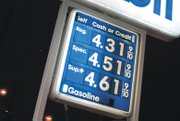Apparel Industry Faces Problems Beyond the Gas Pump
Retailers challenged by high gas prices, inflation and unemployment.
Even as the national economy recovers, Southern California retailers are grappling with a host of economic challenges—high cotton prices and high unemployment, particularly among fashion-hungry teens and 20-somethings—but the rapidly rising price of gas is threatening to take another bite out of retailers’ wallets.
High gas prices have changed the way Fred Levine runs the chain of his six M.Fredric boutiques spread throughout Los Angeles County. The boutique chain’s merchandise is distributed through a central warehouse in Agoura Hills, Calif.
quot;We cut our deliveries from the warehouse to stores down from five days per week to two days even before the gas price increases,quot; Levine said. quot;This hurts our ability to show customers new product more often.quot;
Levine tried one delivery per week in January and February. But the fuel savings were outweighed by added work for store managers. Deliveries became massive because the company was trying to squeeze a week’s worth of deliveries into one trip. The big deliveries also made it challenging to merchandise stores in a timely manner. Even worse, loyal customers were peeved, Levine reported, because they had to wait all week for new deliveries. Levine said he recently solved the problem by instituting a two-delivery-per-week schedule.
It’s a more efficient arrangement. Mileage costs are cut because the company’s two GMC diesel trucks only make their more than 70-mile delivery runs two times each week. When not driving, the drivers work in the warehouse. quot;Even if gas comes down, we might stay at two days a week,quot; Levine said. quot;You learn to get by with just two days of deliveries,quot; he said.
For retailers nationwide, transporting merchandise means working with trucking companies in order to send goods from warehouse to store. Some retailers contained rising gas prices by renegotiating the fuel surcharges in their annual contracts with trucking companies, said Jonathan Gold, vice president of supply chain and customs policy trade group National Retail Federation.
quot;Everybody is looking to make the best deal,quot; Gold said, quot;while ensuring the [transport] providers remain profitable and able to operate.quot;
Ike Zekaria, president of the Windsor prom dress and contemporary fashion store chain, said rising gas prices recently forced his company to stop sending merchandise overnight by air. Rather, his company has been sending merchandise by ground. It might take a few days longer, but Windsor’s freight costs have been cut in half, Zekaria estimated.
But gas prices alone are not the top concern for Zekaria. quot;There’s tons of inflation now. The price of cotton continues to go up; for the first time, we had to raise our prices. So far, the consumer has responded well. But with gas prices going up, their expendable income is being squished,quot; Zekaria said.
For Bob Sayre of Costa Mesa, Calif., boutique The Closet, the chief concern right now is the spending power of his store’s core demographic.
quot;There’s been a much higher unemployment rate in young adults,quot; he said.
In March, 17 percent of youth aged 16 to 24 were unemployed, according to the Bureau of Labor Statistics.
The Closet is currently looking to open new locations, and Sayre plans to follow the customers. The retailer plans to build new stores in retail centers and on fashion streets where there is already a concentration of retail that draws young adults.
Not like 2008
At the start of April, the average price for a gallon of unleaded gas in California was $4.094, according to the Automobile Club of Southern California. The rapid rise in gas prices is reminiscent of summer 2008, when the average price of a gallon of gas was $4.10 nationwide, according to the Auto Club. The 2008 price increase was short-lived, and some are taking the current run-up in gas prices in stride.
quot;High gas prices are a way of life,quot; said Fraser Ross, founder of the Los Angeles–based Kitson chain of boutiques. quot;The roads are still packed. The highways are still congested.quot;
But today’s high gas prices come during a slowly recovering economy—rather than the comparative boom of 2008, said Gila Leibovitch, a retailer who co-owns more than six boutiques. Her Premier Men store is at the Beverly Center in Los Angeles.
quot;Gas prices did not worry me in 2008,quot; she said. quot;We were so busy making money and doing whatever it took to get the goods in the stores that trying to save on gas would have slowed us down.quot;
Post great recession, consumers are more frugal about fashion, and these days, Leibovitch and other retailers are looking for ways to save cash. Vendors are asked to pay for shipping costs. Sometimes Leibovitch and her staff save money by transporting merchandise in their own cars.
Shaheen Sadeghi, owner of Costa Mesa, Calif.– based specialty retail centers The Lab and The Camp, has not noticed a decline in retail traffic lately. But still, he’s preparing for a time when shoppers may be looking for alternate means of transportation.
Last year, Sadeghi set up SoBeCa Bikes, a bicycle-loan program for office workers and neighborhood residents who do not want to drive to his retail centers.
The program’s fleet of 10 bikes is often in use, he said, adding, quot;We’re also starting to see people walk more.quot;























